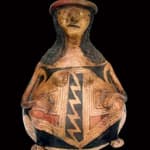Casas Grandes Sculpture in the Form of a Woman, 1160 CE - 1260 CE
Terracotta
7.5
PF.6128
In the region of what is now the vast desert of Northern Chihuahua there once existed a great cultural and trading center known as Casas Grandes. Raw materials such as...
In the region of what is now the vast desert of Northern Chihuahua there once existed a great cultural and trading center known as Casas Grandes. Raw materials such as seashells and tortoise shells were imported, stored, and later worked into jewelry and religious items by Casas Grandes artisans. A wide variety of distinctive pottery was made locally and traded for other styles from regions in the north, including the Anasazi from modern Arizona, via well-worn trails. The cities architecture and public works suggest the presence of an organized government. Similar to the Anasazi, this thriving indigenous society seemed to suddenly vanish, leaving behind nothing more than scorched buildings, deteriorating artifacts, and human and animal remains; frustrating clues for scientists to speculate over the rich cultural traditions of the Casas Grandes pueblo people and their sudden demise.
While anthropomorphic vessels are common in Casas Grandes art, the human figure is generally adapted to the form of the vessel. However, in this exceptional work, the vessel conforms to the contours of the human female body: the rear protrudes into two bulging buttocks and the front stomach swells, suggesting that she is pregnant. Her breasts, arms and legs emerge from the pot and she appears as if seated. Long, flowing hair bound by a red headband covers her head and shoulders. The details of her facial features are clearly modeled including her pupils and nostrils. The surface of the pot has been decorated in gorgeous angular, abstract motifs characteristic of the Casas Grandes style, revealing the influences of their northern neighbors such as the Anasazi. The rich red and black polychrome of the painted decoration enliven the work with a sophisticated charm and grace. Who might this woman represent? A priestess? The wife of a ruler? Or perhaps, a ruler herself? Gazing upon this vessel, we are confronted by the image of an individual from a lost civilization. Although her culture and her people have vanished, this vessel attests to the fact of their existence and highly developed culture. Works such as this vessel are the last echoes of a dying civilizations final cry.
While anthropomorphic vessels are common in Casas Grandes art, the human figure is generally adapted to the form of the vessel. However, in this exceptional work, the vessel conforms to the contours of the human female body: the rear protrudes into two bulging buttocks and the front stomach swells, suggesting that she is pregnant. Her breasts, arms and legs emerge from the pot and she appears as if seated. Long, flowing hair bound by a red headband covers her head and shoulders. The details of her facial features are clearly modeled including her pupils and nostrils. The surface of the pot has been decorated in gorgeous angular, abstract motifs characteristic of the Casas Grandes style, revealing the influences of their northern neighbors such as the Anasazi. The rich red and black polychrome of the painted decoration enliven the work with a sophisticated charm and grace. Who might this woman represent? A priestess? The wife of a ruler? Or perhaps, a ruler herself? Gazing upon this vessel, we are confronted by the image of an individual from a lost civilization. Although her culture and her people have vanished, this vessel attests to the fact of their existence and highly developed culture. Works such as this vessel are the last echoes of a dying civilizations final cry.



